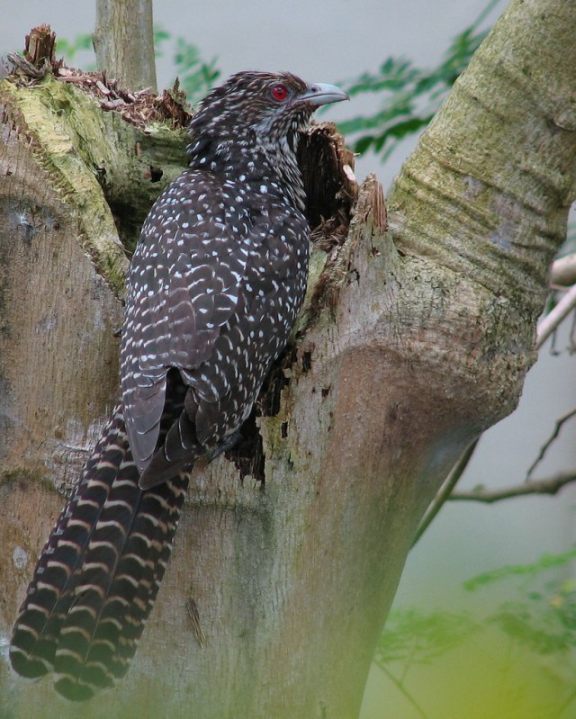|
| 질의: black-headed oriole | 결과: 15번째/15 | |
Asian Koel (Eudynamys scolopacea) - Wiki
| 제목: | Asian Koel (Eudynamys scolopacea) - Wiki
| |

| 해상도: 576x719
파일크기: 82858 Bytes
등록시간: 2008:01:02 16:02:40
|
Asian Koel
From Wikipedia, the free encyclopedia
Order: Cuculiformes
Family: Cuculidae
[Photo] Female Asian Koel (Eudynamys scolopacea). Photograph by J. Sudheesh, Kottayam, Kerala. December 2005. URL: http://en.wikipedia.org/wiki/Image:Eudynamys_scolopacea_f.jpg
The Asian Koel (Eudynamys scolopacea), formerly also Common Koel, is a member of the cuckoo order of birds, the Cuculiformes, which also includes such birds as the roadrunners, the anis, and couas. It is found from southern Asia, China, and into Australia. Like many cuckoos, it lays its eggs in other birds' nests.
The word koel also means "nightingale" in India because of the Indian Koel's melodious call. It is also colloquially known as the Rainbird or Stormbird in eastern Australia, as its call is supposed to foreshadow rain.
Description
The Asian Koel is a large, long-tailed, cuckoo at 45 cm. The male is bluish-black, with a pale green bill, rich red eyes, and grey legs and feet. The female is brownish above and whitish below, but is heavily striped and spotted brown on the underparts and white on the upperparts. She has an olive or green beak and red eyes.
Koels are very vocal, with a number of different calls.
Subspecies
About fifteen subspecies are recognized:
Eudynamys scolopacea scolopacea (Linnaeus, 1758); Pakistan, India, Nepal, Sri Lanka, Laccadives, Maldives;
Eudynamys scolopacea chinensis (Cabanis and Heine,1863); southern China, continental Indochina;
Eudynamys scolopacea harterti (Ingram, 1912); Hainan;
Eudynamys scolopacea malayana (Cabanis and Heine, 1863); S Burma,Thailand, Malay Peninsula, Sumatra, Bangka, Lesser Sundas, Lombok,Sumbawa, Satonda, ?Komodo, Flores, Besar, Paloe),Borneo;
Eudynamys scolopacea mindanensis (Linnaeus,1766) (includes Eudynamys scolopacea paraguena (Hachisuka, 1934),from Palawan, and Eudynamys scolopacea corvina (Stresemann, 1931),from Halmahera); the Philippines (including Palawan and Babuyanes Islands), islands NE of Sulawesi (Talaud Islands (Karakelong,Lirung), Sangihe, Siau, Ruang, Manterawu); northern Moluccas (Morotai, Halmahera, Ternate, Tidore, Moti, Bacan);
Eudynamys scolopacea rufiventer (Lesson, 1830); New Guinea (except southern Irian Jaya);
Eudynamys scolopacea minima van Oordt 1911;southwestern New Guinea;
Eudynamys scolopacea salvadorii Hartert, 1900; Bismarck Archipelago;
Eudynamys scolopacea hybrida Diamond, 2000;Long Island, between New Guinea and New Britain;
Eudynamys scolopacea alberti Rothschild and Hartert, 1907; Solomon Islands;
Eudynamys scolopacrea melanorhyncha S. M??ller, 1843; Sulawesi, Banggai, Muna, Togian Islands, Peleng and Sula Islands (Taliabu, Seho);
Eudynamys scolopacea orientalis (Linnaeus, 1766)(includes Eudynamys scolopacea picata S. M??ller, 1843); C and S Moluccas (Buru, Manipa, Kelang, Seram, Ambon, Tujuh,Watubela Islands);
Eudynamys scolopacea everetti Hartert 1900; Sumba to Timor and Roma, Kai Islands;
Eudynamys scolopacea cyanocephala (Latham 1801);Torres Strait islands north to Boigu and Darnley, N and E Queensland, west to the lower Norman River and north to Cape York and islands off the east coast as far as the Capricorn group, and in New South Wales;
Eudynamys scolopacea subcyanocephala Mathews, 1912; northern Australia (Western Australia, Northern Territories, western Queensland south to Mt Isa and Dolomote and east to the Cloncurry); migrant to New Guinea.
Distribution and habitat
The Asian Koel is a bird of light woodland and cultivation. It is a mainly resident breeder in tropical southern Asia from India and Sri Lanka to south China and Australasia. Birds at the fringes of the range, such as much of Eastern Australia, and on high ground are summer visitors, migrating to warmer areas in winter. They have great potential in colonizing new areas. They first arrived in Singapore in the 1980s and became very common birds.
Behaviour
It is a brood parasite, and lays its single egg in the nests of a variety of birds, including the Jungle Crow, House Crow and various species of honeyeaters. May also parasitize Black-headed Orioles. The young Koel does not always evict its host's chicks, and initially calls like a crow. The adult koels however may not be leaving their offspring alone entirely:
"The Indian koel (Eudynamys honorata) is the rain - bird of India. The bird is parasitic on crows, and it would appear from the notes of naturalists in India that the koels must look after their offspring to a certain extent, for they have been seen feeding their own young ones after they have left the nest." ???Lydekker
This behaviour of brood parasites feeding their young has been noted in several other species. The note alluded to by Richard Lydekker is probably that of A. O. Hume which was noted by Fulton in 1904.
Diet
The Asian Koel is omnivorous, consuming a variety of insects, caterpillars, eggs and small vertebrates. Adults predominanty feed on fruit. It has occasionally been known to take eggs of small birds.
http://en.wikipedia.org/wiki/Asian_Koel
| The text in this page is based on the copyrighted Wikipedia article shown in above URL. It is used under the GNU Free Documentation License. You may redistribute it, verbatim or modified, providing that you comply with the terms of the GFDL. |
|
댓글 |
|---|
| | 손님 |
|
| Asian Koel Eudynamys scolopaceus 초록부리뻐꾸기(검은뻐꾸기) |
^o^
동물그림창고 똑똑전화 누리집
^o^
|
|
|